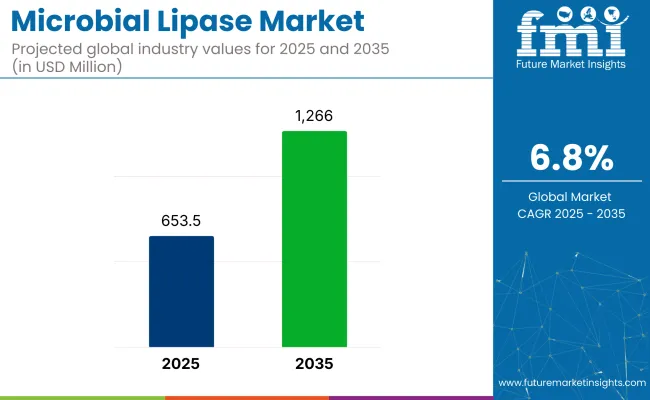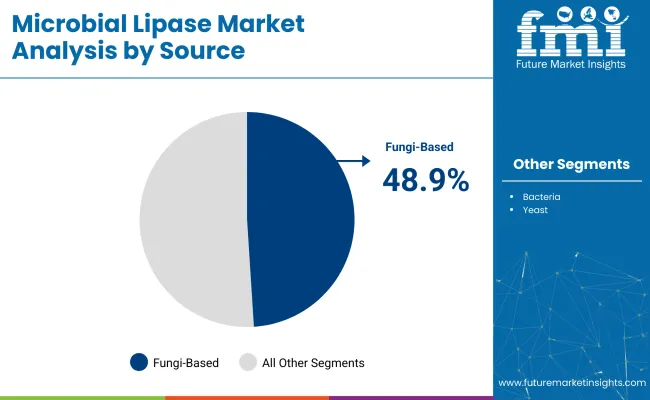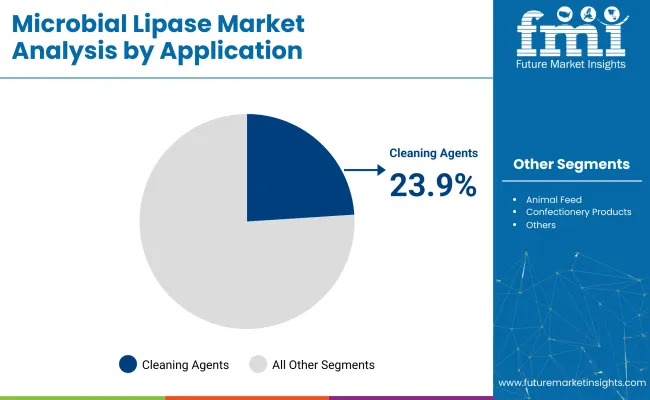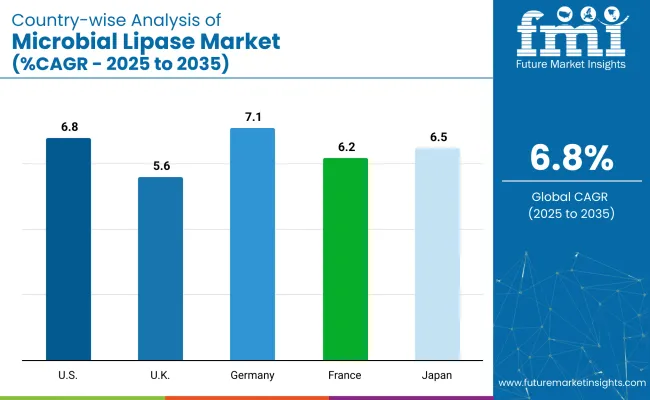The microbial lipase market is valued at USD 653.5 million and is forecast to reach USD 1,266.0 million by 2035, which shows a CAGR of 6.8%.

| Metric | Value |
|---|---|
| Market Value (2025) | USD 653.5 million |
| Market Value (2035) | USD 1,266.0 million |
| CAGR (2025 to 2035) | 6.8% |
Technological advancements in fermentation and bioprocessing have allowed for greater yield and functional enzyme customization, benefiting major players such as Novozymes, Amano Enzyme, and DSM.Microbial lipases, which catalyze the breakdown of fats, are preferred in industrial processes for their specificity and eco-friendly nature. The market is witnessing a shift from chemical surfactants to enzyme-based alternatives, especially in the detergent and food processing sectors. This transformation is also aided by rising awareness of clean-label ingredients and the growing need for biodegradable, sustainable inputs.
Research institutions and industry players are collaborating more frequently, promoting innovations in enzyme purification and fermentation technology. The emphasis on renewable feedstock utilization, low-energy enzymatic reactions, and reduction of processing residues is expected to define the microbial lipase production landscape for the next decade. The convergence of synthetic biology, AI-led strain design, and sustainable manufacturing positions microbial lipases as critical agents in industrial biotransformation.
Key application areas such as biodiesel production are also seeing a surge in microbial lipase use, due to the enzyme's role in enhancing transesterification processes. In terms of application, the cleaning agents segment holds 23.9% share. On the basis of source, the fungi-derived lipases segment accounts for 48.9% share.The USA is poised to grow at 6.8% CAGR during the study period.
The microbial lipase market falls under the broader functional food ingredients and industrial enzymes categories. It represents a niche yet rapidly growing subset within the global enzyme industry, which includes proteases, amylases, and carbohydrases. Microbial lipases contribute approximately 8-10% of the global industrial enzymes market and around 12-15% within the specialty food enzymes segment. With increasing applications in both household and industrial bio-catalysis, microbial lipases are also influencing innovation in sectors like green chemistry and biopharmaceuticals.
The market is segmented by source into fungi, bacteria, and yeast; by form into powder and liquid; by application into cleaning agents, animal feed, dairy products, bakery products, confectionery products, and other applications (pharmaceuticals, leather processing, biodiesel production, cosmetics, and wastewater treatment); and by region into North America, Latin America, Europe, East Asia, South Asia, Oceania, and the Middle East & Africa (MEA).
Fungi-derived microbial lipases dominate the source segment, holding approximately 48.9% of the global market share in 2025.

Powdered microbial lipases are set to lead the form segment, commanding a 58.2% market share in 2025.
Cleaning agents account for the largest share of the microbial lipase market by application, holding 23.9% market share in 2025.

The market is witnessing consistent expansion, fueled by increasing demand for enzyme-based alternatives in food processing, cleaning, and biofuel production. Growing preference for natural, biodegradable enzymes, rising clean-label food trends, and advancements in fermentation technology are contributing significantly to market acceleration. Additionally, partnerships between enzyme producers and research institutions are driving innovation in lipase specificity and industrial applicability.
Recent Trends in the Microbial Lipase Market
Challenges in the Microbial Lipase Market

Among the top five countries, Germany is projected to witness the fastest growth in the microbial lipase market with a CAGR of 7.1% from 2025 to 2035, driven by strong industrial biotech adoption and R&D investments. The USA follows closely with 6.8% CAGR, supported by clean-label trends and biofuel sector expansion. Japan and France are expected to grow at 6.5% and 6.2% CAGR respectively, fueled by applications in personal care and food processing. The UK shows steady but comparatively lower growth at 5.6% CAGR, reflecting its mature market and stringent sustainability standards across detergent and food enzyme use cases.
The report covers an in-depth analysis of 40+ countries; five top-performing OECD countries are highlighted below.
The microbial lipase demand in the USA is projected to grow at a CAGR of 6.8% from 2025 to 2035.
Demand for microbial lipase in the UK is projected to grow steadily at a CAGR of 5.6% from 2025 to 2035.
Germany’s microbial lipase revenue is projected to grow at a CAGR of 7.1% from 2025 to 2035.
Demand for microbial lipase in France is projected to grow at a CAGR of 6.2% from 2025 to 2035.
Microbial lipase revenue in Japan is projected to grow at a CAGR of 6.5% from 2025 to 2035.
The microbial lipase market is moderately fragmented, with a mix of global enzyme giants and specialized biotech firms. Novozymes, BASF, and DSM lead as Tier 1 players, leveraging advanced fermentation technologies, global distribution networks, and strong R&D pipelines. Amano Enzyme, AB Enzymes, and Chr.
Hansen follow in Tier 2, focusing on tailored applications in food, feed, and detergents. Enzyme Development Corp., Biocatalysts, and Genomatica represent Tier 3 players, offering niche solutions and innovative enzyme formulations for specific industrial needs. Strategic collaborations, patent filings, and expansion into clean-label and sustainable enzyme markets define the competition. Continuous innovation in strain engineering and production efficiency remains key to gaining market share amid growing demand for natural and eco-friendly enzyme solutions.
Recent Microbial Lipase Industry News
| Report Attributes | Details |
|---|---|
| Current Total Market Size (2025) | USD 653.5 million |
| Projected Market Size (2035) | USD 1,266.0 million |
| CAGR (2025 to 2035) | 6.8% |
| Base Year for Estimation | 2024 |
| Historical Period | 2020 to 2024 |
| Projections Period | 2025 to 2035 |
| Market Analysis Parameters | Revenue in USD million/Volume in Kilo Tons |
| By Source | Fungi, Bacteria, and Yeast |
| By Form | Powder and Liquid |
| By End Use Industry | Agriculture (Commercial Farming, Organic Farming), Animal Feed, Aquaculture, Horticulture |
| By Application | Cleaning Agents, Animal Feed, Dairy Products, Bakery Products, Confectionery Products, and Other Applications (Pharmaceuticals, Leather Processing, Biodiesel Production, Cosmetics, and Wastewater Treatment) |
| Regions Covered | North America, Latin America, Western Europe, Eastern Europe, East Asia, South Asia & Pacific, Middle East & Africa |
| Countries Covered | United States, Canada, United Kingdom, Germany, France, China, Japan, South Korea, Brazil, Australia |
| Key Players | Novozymes , BASF, DSM, Amano Enzyme, AB Enzymes, Chr. Hansen, Enzyme Development Corp., Biocatalysts, Genomatica |
| Additional Attributes | Dollar sales by value, market share analysis by region, and country-wise analysis. |
Fungi, Bacteria, and Yeast.
Powder and Liquid.
Industry Agriculture (Commercial Farming, Organic Farming), Animal Feed, Aquaculture, Horticulture.
Cleaning Agents, Animal Feed, Dairy Products, Bakery Products, Confectionery Products, and Other Applications (Pharmaceuticals, Leather Processing, Biodiesel Production, Cosmetics, and Wastewater Treatment).
Regions Covered North America, Latin America, Western Europe, Eastern Europe, East Asia, South Asia & Pacific, Middle East & Africa.
The market is valued at USD 653.5 million in 2025.
The market is expected to grow at a CAGR of 6.8% during 2025 to 2035.
The market is projected to reach a value of USD 1,266.0 million by 2035.
Fungi-derived species hold the largest market share among sources in 2025, accounting for approximately 48.9% of the market.
Powder is the leading form in 2025, holding 58.2% market share.






Our Research Products

The "Full Research Suite" delivers actionable market intel, deep dives on markets or technologies, so clients act faster, cut risk, and unlock growth.

The Leaderboard benchmarks and ranks top vendors, classifying them as Established Leaders, Leading Challengers, or Disruptors & Challengers.

Locates where complements amplify value and substitutes erode it, forecasting net impact by horizon

We deliver granular, decision-grade intel: market sizing, 5-year forecasts, pricing, adoption, usage, revenue, and operational KPIs—plus competitor tracking, regulation, and value chains—across 60 countries broadly.

Spot the shifts before they hit your P&L. We track inflection points, adoption curves, pricing moves, and ecosystem plays to show where demand is heading, why it is changing, and what to do next across high-growth markets and disruptive tech

Real-time reads of user behavior. We track shifting priorities, perceptions of today’s and next-gen services, and provider experience, then pace how fast tech moves from trial to adoption, blending buyer, consumer, and channel inputs with social signals (#WhySwitch, #UX).

Partner with our analyst team to build a custom report designed around your business priorities. From analysing market trends to assessing competitors or crafting bespoke datasets, we tailor insights to your needs.
Supplier Intelligence
Discovery & Profiling
Capacity & Footprint
Performance & Risk
Compliance & Governance
Commercial Readiness
Who Supplies Whom
Scorecards & Shortlists
Playbooks & Docs
Category Intelligence
Definition & Scope
Demand & Use Cases
Cost Drivers
Market Structure
Supply Chain Map
Trade & Policy
Operating Norms
Deliverables
Buyer Intelligence
Account Basics
Spend & Scope
Procurement Model
Vendor Requirements
Terms & Policies
Entry Strategy
Pain Points & Triggers
Outputs
Pricing Analysis
Benchmarks
Trends
Should-Cost
Indexation
Landed Cost
Commercial Terms
Deliverables
Brand Analysis
Positioning & Value Prop
Share & Presence
Customer Evidence
Go-to-Market
Digital & Reputation
Compliance & Trust
KPIs & Gaps
Outputs
Full Research Suite comprises of:
Market outlook & trends analysis
Interviews & case studies
Strategic recommendations
Vendor profiles & capabilities analysis
5-year forecasts
8 regions and 60+ country-level data splits
Market segment data splits
12 months of continuous data updates
DELIVERED AS:
PDF EXCEL ONLINE
Microbial Growth Monitoring System Market Size and Share Forecast Outlook 2025 to 2035
Microbial Coagulants Market Size and Share Forecast Outlook 2025 to 2035
Microbial Polyketides Market Analysis - Size, Share, and Forecast Outlook 2025 to 2035
Microbial Nucleotides Market Analysis - Size, Share, and Forecast Outlook 2025 to 2035
Microbial Fermentation Technology Market Size and Share Forecast Outlook 2025 to 2035
Microbial Gene Editing Services Market Size and Share Forecast Outlook 2025 to 2035
Microbial Lipids Size and Share Forecast Outlook 2025 to 2035
Microbial Therapeutic Products Market Size and Share Forecast Outlook 2025 to 2035
Analysis and Growth Projections for Microbial Seed Treatment Business
Analysis and Growth Projections for Microbial Food Culture Business
Microbial Protein Used in Feed Market Analysis by Application, Source, and Region Through 2035
Microbial Identification Market Report – Growth & Forecast 2025-2035
Microbial Feed Additives Market – Growth, Probiotics & Livestock Nutrition
Microbial Bioreactors Market
Microbial Rennet Market
Antimicrobial HVAC Coating Market Size and Share Forecast Outlook 2025 to 2035
Antimicrobial Hospital Textile Market Forecast Outlook 2025 to 2035
Antimicrobial Glass Powder Market Forecast and Outlook 2025 to 2035
Antimicrobial Cap Fitters Market Size and Share Forecast Outlook 2025 to 2035
Antimicrobial Powder Coating Market Size and Share Forecast Outlook 2025 to 2035

Thank you!
You will receive an email from our Business Development Manager. Please be sure to check your SPAM/JUNK folder too.
Chat With
MaRIA